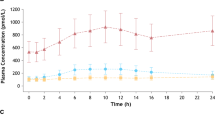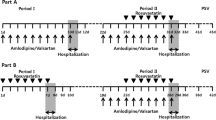Abstract
The pharmacokinetics and pharmacodynamics of single oral doses of 5 mg ramipril and 6 mg piretanide administered separately and in combination were determined in a single blind, randomised, 3-period cross-over study in 24 healthy male volunteers.
The peak plasma concentrations of ramipril and ramiprilat increased slightly (from 11.9 to 14.8 ng/ml, and from 6.39 to 8.96 ng/ml, respectively) as did the area under the plasma concentration-time curve of ramipril (0–4 h) and ramiprilat (0–24 h) (from 15.8 to 19.8 ng·ml−1·h, and from 63.4 to 74.6 ng·ml−1·h, respectively). The urinary excretion of ramiprilat also rose (from 6.82 to 7.73 % of dose) following simultaneous treatment with piretanide. These effects were probably due to reduced first-pass metabolism of ramipril/ramiprilat to inactive metabolites. The blood pressure lowering effect, the time course of inhibition of ACE activity in plasma and the concentration-response relationship for the inhibition of plasma ACE activity were not affected by piretanide.
The peak plasma concentration of piretanide was somewhat reduced (from 285 to 244 ng/ml) following simultaneous treatment with ramipril. No other pharmacokinetic parameter was affected. Piretanide increased urine flow, and sodium, chloride and potassium excretion, especially during the first 2 hours following administration. These pharmacodynamic parameters were not affected by ramipril.
Thus, simultaneous administration of single oral doses of ramipril and piretanide caused modest changes in the peak and average plasma concentrations of both drugs, which did not lead to detectable alterations in the pharmacodynamic parameters measured in healthy volunteers.
Similar content being viewed by others
References
Antonaccio MJ (1982) Angiotensin converting enzyme (ACE) inhibitors. Ann Rev Pharmacol Toxicol 22: 57–87
Atlas SA, Case DB, Sealey JE, Laragh JH, McKinstry DN (1979) Interruption of the renin-angiotensin system in hypertensive patients by captopril induces sustained reduction in aldosterone secretion, potassium retention and natriuresis. Hypertension 1: 274–280
Becker RH, Baldes L, Treudler M (1989) Loop diuretics combined with an ACE inhibitor for treatment of hypertension: a study with furosemide, piretanide and ramipril in spontaneously hypertensive rats. J Cardiovasc Pharmacol 13 [Suppl 3]: S35-S39
Becker RHA, Schoelkens BA, Metzger M, Schulze KJ (1984) Pharmacological properties of the new orally active angiotensin converting enzyme inhibitor 2-[N-[S)--1-ethoxycarbonyl-3-phenylpropyl]-L-alanyl]-(1S,3S,5S)-2-azabicyclo[3.3.0]octane-3-carboxylic acid (HOE 498). Arzneimittelforschung — Drug Res 34: 1411–1416
Brater DC, Anderson S, Baird B, Kanjareern S (1981) Effects of piretanide in normal subjects. Clin Pharmacol Ther 35: 324–330
Brunner DB, Desponds G, Biollaz J, Keller I, Ferber F, Gavras H, Brunner HR, Schelling JL (1981) Effect of a new angiotensin converting enzyme inhibitor MK 421 and its lysine analogue on the components of the renin system in healthy subjects. Br J Clin Pharmacol 11: 461–467
Eckert H-G, Münscher G, Oekonomopulos R, Strecker H, Urbach H, Wissmann H (1985) A radioimmunoassay for the angiotensin converting enzyme inhibitor ramipril and its active metabolite. Arzneimittelforschung — Drug Res 35: 1251–1256
Heptner W, Baudner S, Dagrosa EE, Hellstern C, Irmisch R, Strecker H, Wissmann H (1984) A radioimmunoassay to measure piretanide in human serum and urine. J Immunoassay 5: 13–27
Lawrence JR, Ansard AF, Elliott HL, Summer DJ, Brunton GF, Whiting O, Whitesmith R (1978) Kinetic and dynamic comparison of piretanide and furosemide. Clin Pharmacol Ther 23: 558–565
Lederle RM (1985) Captopril and hydrochlorothiazide in the fixed combination multicenter trial. J Cardiovasc Pharmacol 7 [Suppl 1]: S63-S69
Luus HG, Muller FO, Meyer BH (1989a) Statistical significance versus clinical relevance. I. The essential role of the power of a statistical test. S Afr Med J 76: 588–570
Luus HG, Muller FO, Meyer BH (1989b) Statistical significance versus clinical relevance. II. The use and interpretation of confidence intervals. S Afr Med J 76: 626–629
Luus HG, Muller FO, Meyer BH (1989c) Statistical significance versus clinical relevance. III. Methods for calculating confidence intervals. S Afr Med J 76: 681–685
Metz M (1988) Treatment of severe essential hypertension. Antihypertensive effects of enalapril alone and in combination with furosemide. Münch Med Wochenschr 130: 539–542
Odlind B (1979) Relation between renal tubular secretion and effects of five loop diuretics. J Pharmacol Exp Ther 211: 238–244
Olsen ME, Hall JE, Montani J-P, Guyton AC, Langford HG, Cornell JE (1985) Mechanisms of angiotensin II natriuresis and antinatriuresis. Am J Physiol 249: F299–307
Ramsay LE, McInnes GT, Hettiarackchi J, Shelton J, Scott P (1978) Bumetanide and furosemide. A comparison of dose-response curves in healthy men. Br J Clin Pharmacol 5: 243–247
Schmidt D, Keller A (1985) Eine empfindliche Methode zur Bestimmung des ACE-Hemmers HOE 498 und dessen Metaboliten in Humanurin mittels Capillarsäulen-Gas-Chromatographie. Fresenius Z Anal Chem 320: 731
Steinijans VW, Diletti E (1983) Statistical analysis of bioavailability studies: parametric and nonparametric confidence intervals. Eur J Clin Pharmacol 24: 127–136
Steinijans VW, Hartmann M, Huber R, Radtke HW (1991) Lack of pharmacokinetic interaction as an equivalent problem. Int J Clin Pharmacol Ther Toxicol 29: 323–328
Weinberger MH (1989) Angiotensin converting enzyme inhibitors enhance the antihypertensive efficacy of diuretics and blunt or prevent adverse metabolic effects. J Cardiovasc Pharmacol 13 [Suppl 3]: S1-S4
Witte PU, Irmisch R, Hajdú P, Metzger H (1984) Pharmacokinetics and pharmacodynamics of a novel orally active angiotensin converting enzyme inhibitor (HOE 498) in healthy subjects. Eur J Clin Pharmacol 27: 577–581
Author information
Authors and Affiliations
Rights and permissions
About this article
Cite this article
Ruf, G., Gera, S., Luus, H.G. et al. Pharmacokinetics and pharmacodynamics of ramipril and piretanide administered alone and in combination. Eur J Clin Pharmacol 46, 545–550 (1994). https://doi.org/10.1007/BF00196113
Received:
Accepted:
Issue Date:
DOI: https://doi.org/10.1007/BF00196113




